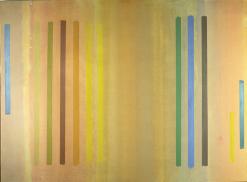
William Perehudoff was born in Langham, Saskatchewan and has maintained a connection to this area ever since. Currently dividing his time between Saskatoon and the family farm, which has been developed into an art compound encompassing studios and storage facilities for himself and his wife, Dorothy Knowles, he continues his practice as a leading Canadian painter. In 1944, the Saskatoon Art Centre opened, and this provided Perehudoff with early and important access to art. Within a couple of years he was exhibiting regularly in group exhibitions such as the Saskatoon Exhibition and the Art Centre fall show. Throughout this phase of his development as an artist, he farmed in the summer and devoted himself to painting and his art education in the winter. In the late 1940s, Perehudoff worked as a labourer at Fred Mendel's meat-packing plant, Intercontinental Packers, in Saskatoon. Like many artists of the time, Perehudoff had been influenced by the motivations and methodologies of social realist artists such as Diego Rivera. He was commissioned by Fred Mendel to paint murals for the meat-packing plant cafeteria walls. Except for brief periods, the murals remained in place until 2002, when they were acquired and donated to the Mendel Art Gallery in Saskatoon by Camille Mitchell, Mendel's granddaughter. The murals portray the entire meat-packing process from the delivery of live animals to the point at which the meat leaves the plant, destined for market.
Shortly after completing this commission, Perehudoff travelled to Colorado Springs to take instruction with influential French muralist Jean Charlot. A few years later, in New York, he studied with Amédé Ozenfant, the French Purist and associate of Le Corbusier. In 1962, Perehudoff met Clement Greenberg at an Emma Lake Workshop; Greenberg, a passionate advocate of abstraction, was perhaps the most prolific and influential New York art critic of the 20th century. The following year, Perehudoff worked with Kenneth Noland, a very important colourfield painter and a major influence.
Since the 1960s, Perehudoff has been a central figure in Canadian abstraction and perhaps its most celebrated colourfield painter. The effect of the flat plains and open skies that are so dramatically in evidence throughout Saskatchewan seem to some to be very present in his work. What seems certain is that over the years his subtle yet exacting command of colour and shapes, their resolution and correspondences, and their ability to communicate to the viewer, combine to form a kind of personal language. His international career is about his work, his mastery of form, and this very personal vocabulary. William Perehudoff received the Saskatchewan Order of Merit in 1994 and an honorary doctorate from the University of Regina in 2003. He was named a Member of the Order of Canada in 1998.
Gilles Hebert
Print EntryHOME | BROWSE BY SUBJECT | ENTRY LIST (A-Z) | IMAGE INDEX | CONTRIBUTOR INDEX | ABOUT THE ENCYCLOPEDIA | SPONSORS TERMS OF USE | COPYRIGHT © 2006 CANADIAN PLAINS RESEARCH CENTER, UNIVERSITY OF REGINA | POWERED BY MERCURY CMS |
|||
| This web site was produced with financial assistance provided by Western Economic Diversification Canada and the Government of Saskatchewan. |
|||
 |
 |
 |
 |
| Ce site Web a été conçu grâce à l'aide financière de Diversification de l'économie de l'Ouest Canada et le gouvernement de la Saskatchewan. |
|||